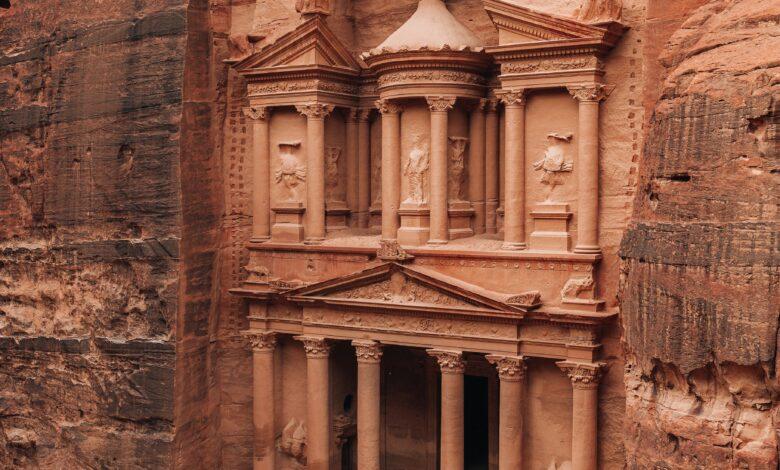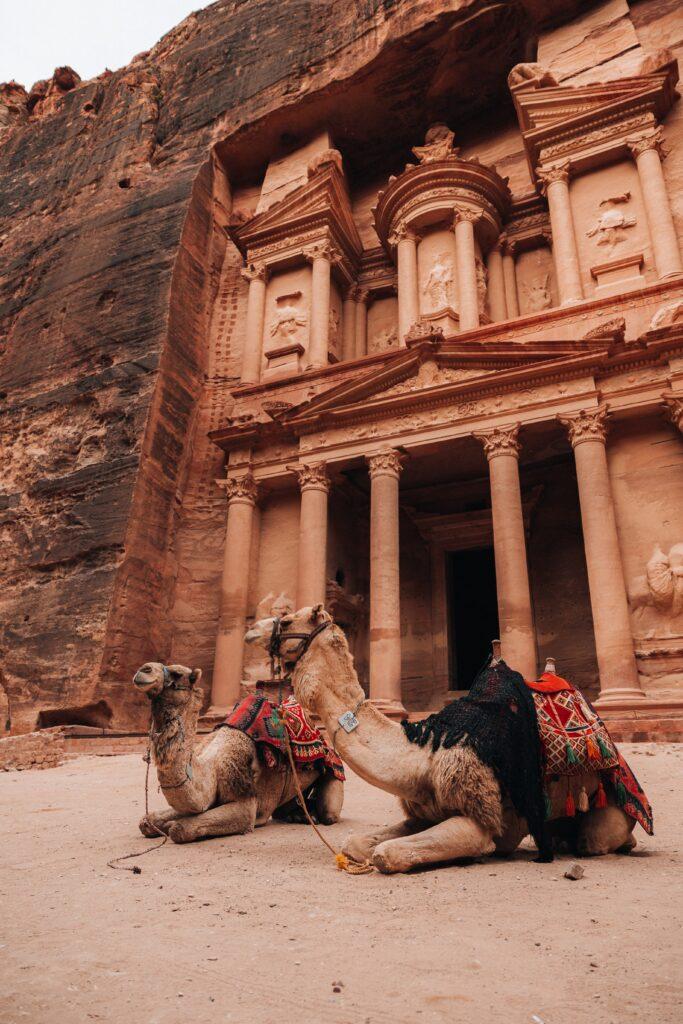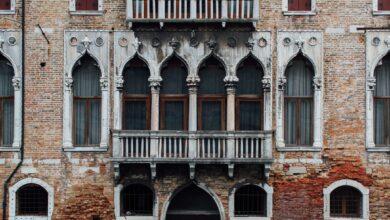🏛️ Wonders of Petra, Jordan: Rose City in the Desert 🌹🏜️
Unveiling the Magnificence of Petra's Ancient Marvels

Introduction
Nestled in the rugged landscapes of Jordan, Petra stands as a testament to the ingenuity and resilience of ancient civilizations. Known as the “Rose City” for its rosy-hued rock-cut architecture, Petra has captured the imaginations of travelers and historians alike. This UNESCO World Heritage Site boasts a rich history, dating back to its role as the capital of the Nabataean Kingdom. As we embark on this journey, let’s unravel the wonders of Petra, exploring its architectural marvels, cultural significance, and the challenges it faces in the modern world.
History and Origins of Petra
Petra, an archaeological wonder nestled in the rugged desert canyons of southern Jordan, boasts a rich history that dates back to ancient times. Believed to have been established as early as the 4th century BCE, Petra’s origins are shrouded in mystery. The city’s unique rock-cut architecture and intricate structures suggest a civilization with advanced engineering and architectural prowess. Some theories posit that Petra may have been initially settled by the Edomites, while others connect its early inhabitants to the Nabataeans.
Establishment and Early History
The exact establishment of Petra remains elusive, but archaeological evidence indicates that it was likely a bustling hub of activity as far back as the 4th century BCE. The city’s strategic location along key trade routes facilitated its growth, attracting diverse cultures and fostering a melting pot of influences. The Nabataeans, skilled traders and builders, played a pivotal role in shaping Petra into a flourishing city with its iconic facades carved into the rose-red cliffs.
Role as the Capital of the Nabataean Kingdom
Petra reached the zenith of its glory during its time as the capital of the Nabataean Kingdom. The Nabataeans, adept at harnessing water through ingenious systems, transformed Petra into a thriving oasis amid the arid landscape. The city became a center for commerce, culture, and religion, boasting temples, tombs, and theaters that reflected the sophistication of its inhabitants. The iconic Al-Khazneh (The Treasury) and the Monastery are testament to the architectural brilliance of the Nabataeans.
Strategic Location for Trade and Commerce
Petra’s strategic location at the crossroads of major trade routes contributed significantly to its prosperity. The city served as a vital nexus for the spice and silk trade between the East and West, making it an economic powerhouse. Caravans laden with precious goods traversed the arid landscapes to converge at Petra, facilitating cultural exchange and economic growth. The wealth accumulated through trade allowed the Nabataeans to adorn Petra with grand structures, establishing it as a jewel of the ancient world.
Architectural Marvels of Petra
Petra, often referred to as the “Rose City,” is renowned for its breathtaking architectural marvels that showcase the ingenuity of the ancient Nabataeans. From the awe-inspiring entrance through The Siq to the remote grandeur of the Monastery, each structure in Petra is a testament to the city’s rich cultural and historical significance.
The Siq: Gateway to Petra
The journey into Petra begins with The Siq, a narrow and winding gorge that serves as the main entrance to the city. As visitors traverse this mesmerizing pathway flanked by towering cliffs, they are greeted with anticipation as glimpses of Petra’s iconic structures gradually unfold. The Siq, with its natural geological formations and intricate rock carvings, sets the stage for the grandeur that awaits within.
Al-Khazneh (The Treasury): Iconic Facade
Arguably the most famous of Petra’s structures, Al-Khazneh, also known as The Treasury, stands as an enduring symbol of the city. Carved directly into the rose-red cliffs, this monumental façade is an architectural masterpiece. The intricate detailing and precision with which it was crafted evoke a sense of wonder and mystery. Al-Khazneh’s purpose has been the subject of much speculation, with theories ranging from a mausoleum to a ceremonial treasury.
Monastery (Ad Deir): Remote Grandeur
Venturing further into Petra reveals the majestic Monastery, also known as Ad Deir. Situated atop a hill and accessible by a challenging ascent, the Monastery impresses with its sheer size and remote grandeur. The journey to reach this monumental structure is rewarded with panoramic views of the surrounding landscapes. The Monastery’s design echoes that of Al-Khazneh but on a larger scale, emphasizing the Nabataeans’ architectural prowess.
Royal Tombs: Majestic Burial Sites
Petra’s landscape is adorned with a series of Royal Tombs, each a testament to the significance of the city’s elite. These majestic burial sites, carved into the cliffs with intricate architectural details, reflect the wealth and power of the Nabataean rulers. The Royal Tombs, including the Urn Tomb and the Corinthian Tomb, stand as lasting tributes to the grandeur of Petra’s past.
The Great Temple: Religious Significance
At the heart of Petra lies The Great Temple, a complex that holds immense religious and civic importance. The temple’s grand architecture and expansive layout underscore its role as a center for communal gatherings and religious ceremonies. The Great Temple stands as a reminder of the spiritual and cultural dimensions that enriched the daily life of the Nabataean people.
In essence, the architectural wonders of Petra narrate a tale of a sophisticated and thriving ancient city, where innovation and artistic expression converged to create a legacy that continues to captivate visitors from around the world. Each structure, from The Siq to The Great Temple, contributes to the unique tapestry of Petra’s architectural brilliance.

Engineering Feats: Water Management in the Desert
In the heart of the arid desert landscape of Petra, the Nabataeans demonstrated unparalleled engineering prowess in their mastery of water management. The ingenious solutions devised by this ancient civilization were instrumental in transforming Petra into a thriving oasis, enabling the sustained growth of its population and contributing to the city’s prominence as a trade and cultural hub.
Elaborate Water Conduit Systems
One of the remarkable engineering feats of the Nabataeans was the creation of an elaborate network of water conduit systems. These channels, carved directly into the rock, were designed to capture and direct scarce rainfall toward the heart of the city. The intricate system harnessed every drop of precious water, ensuring a consistent and efficient supply to sustain the needs of Petra’s residents. The Nabataeans’ understanding of hydrology and their ability to manipulate the terrain for optimal water collection showcase their advanced engineering skills.
Dams and Cisterns: Ingenious Water Conservation
To supplement the unpredictable rainfall, the Nabataeans constructed dams and cisterns strategically throughout Petra. These structures served a dual purpose: they captured and stored rainwater during the infrequent downpours, and they mitigated the risk of flash floods. The Nabataeans’ mastery of dam construction allowed them to control the flow of water, directing it to reservoirs for storage. The cisterns, often carved into the rock, acted as essential repositories, ensuring a reliable water supply during dry periods.
Role of Water in Sustaining Petra’s Population
Water was the lifeblood of Petra, and the Nabataeans’ innovative water management systems played a pivotal role in sustaining the city’s population. The availability of water not only met the basic needs of the residents but also supported agricultural activities, allowing the cultivation of crops in the arid environment. The prosperity brought about by reliable access to water contributed to the economic and cultural flourishing of Petra, attracting traders, merchants, and diverse communities to the city.
Cultural Significance and Religious Practices
Petra, beyond its architectural splendors, holds profound cultural and religious significance that reflects the diverse influences of its inhabitants. The city served as a melting pot where various cultures converged, leaving an indelible mark on its religious practices and cultural fabric.
Diverse Religious Influences
The cultural tapestry of Petra was woven with threads from different civilizations, leading to a rich tapestry of religious diversity. Influences from Arabian, Greco-Roman, and indigenous Nabataean cultures intertwined to create a unique religious landscape. This diversity is evident in the presence of temples, altars, and sacred spaces dedicated to a pantheon of deities, showcasing the acceptance and assimilation of various religious beliefs within Petra.
Nabataean Gods and Goddesses
Central to the religious practices in Petra were the Nabataean gods and goddesses, each with specific attributes and significance. The primary deity, Dushara, was considered the god of the Nabataean people, associated with protection and well-being. Other deities included Al-Uzza, the goddess of fertility, and Allat, associated with the moon. The Nabataeans expressed their devotion through elaborate rituals and ceremonies conducted in temples and sacred sites dedicated to these deities.
Rituals and Ceremonies in Petra
The religious practices in Petra were marked by a variety of rituals and ceremonies that played a crucial role in the daily lives of its inhabitants. Temples and altars served as focal points for religious gatherings, where priests and devotees engaged in ceremonies to seek divine favor, express gratitude, or request protection. The rituals ranged from simple offerings to elaborate processions, illustrating the depth of religious devotion within the community.
The synthesis of diverse religious influences in Petra fostered a unique cultural and spiritual identity. The city’s religious practices were not only a reflection of the Nabataeans’ beliefs but also a testament to their openness to cultural exchange and adaptation. As visitors explore the archaeological wonders of Petra, they witness not only the architectural brilliance but also the echoes of ancient rituals that once resonated through the rose-red city, connecting its people to the divine in a harmonious blend of traditions.
Petra in Popular Culture
Petra’s mesmerizing beauty and historical significance have transcended time, making it a captivating subject in movies, literature, and popular culture. The enigmatic allure of the Rose City has inspired storytellers and creators, weaving its wonders into the fabric of artistic expression.
In movies and literature, Petra often serves as a backdrop for tales of adventure, mystery, and exploration. Films such as “Indiana Jones and the Last Crusade” immortalized Petra’s Al-Khazneh (The Treasury) as the fictional temple housing the Holy Grail. Literary works, too, have embraced Petra’s mystique, incorporating its unique landscapes and ancient history into narratives that capture the imagination of audiences around the world.
Influence on Modern Architecture and Design
Petra’s architectural marvels have not only stood the test of time but have also left an indelible mark on modern architecture and design. The intricate rock-cut facades and the city’s overall layout have inspired architects and designers globally. The concept of blending structures with the natural environment, a hallmark of Nabataean architecture, can be seen in contemporary buildings that seek to harmonize with their surroundings. The aesthetics of Petra continue to echo in the lines and curves of modern structures, creating a bridge between ancient ingenuity and contemporary design.
Tourism and its Impact on Petra’s Preservation
As one of the New Seven Wonders of the World, Petra has become a magnet for tourists from every corner of the globe. While tourism has brought economic opportunities to the region, it also poses challenges to the preservation of this archaeological gem. The influx of visitors, if not carefully managed, can contribute to wear and tear on the ancient structures. Balancing the desire to share Petra’s wonders with the world while preserving its integrity requires thoughtful conservation efforts, responsible tourism practices, and strategic planning to ensure that future generations can continue to marvel at Petra’s beauty.
FAQs
Q. Is Petra safe for tourists?
A. Petra is generally considered safe for tourists. However, it’s advisable to stay updated on travel advisories and follow local guidelines.
Q. How long does it take to explore Petra?
A. Plan at least two to three days to fully explore Petra, allowing time for both main attractions and hidden gems.
Q. Can you enter Petra by Night with a regular ticket?
A. No, Petra by Night requires a separate ticket, providing a unique and enchanting nighttime experience.
Q. Are guided tours available in Petra?
A. Yes, guided tours are available and highly recommended to gain deeper insights into Petra’s history and significance.
Q. What is the best time to visit Petra?
A. The spring and autumn months offer the most pleasant weather for exploring Petra’s wonders.
Q. Are there dining options within Petra?
A. Absolutely, Petra offers various dining options, allowing visitors to savor authentic Jordanian cuisine amid the ancient ruins.
Conclusion
In concluding our exploration of Petra, the Rose City in the Desert, we find ourselves marveling at the remarkable achievements of the Nabataean people. The intricate rock-cut architecture, the ingenious water management systems, and the cultural tapestry woven through the city’s history all contribute to Petra’s standing as a global treasure. As stewards of this legacy, it is our collective responsibility to preserve and protect Petra for future generations. Let us continue to appreciate and respect the wonders of Petra, ensuring that this extraordinary piece of our shared human history endures the sands of time.





Facebook Comments